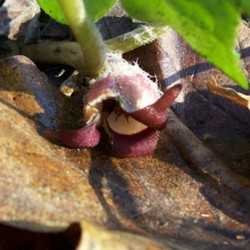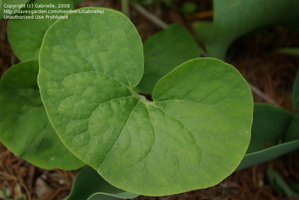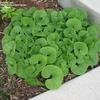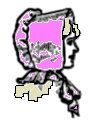





In the early winter on the way home from school, I would often stop by Aunt Bett's house at the mouth of the holler. Sometimes when I walked in I could smell the sweet aroma of baking gingerbread, and I knew Christmas was on the way! Aunt Bett and my Granny Ninna could bake the very best gingerbread, and I always got to make my own gingerbread man from the last pieces of the dough.
(Editor's Note: This article was originally published on October 7, 2008. We hope you enjoy it as we count down to Christmas but please keep in mind that authors of previously published articles may not be able to respond to questions and comments.)
"Run, run, fast as you can, You can't catch me, I'm the Gingerbread Man"...from an old Folktale
The lowest area between two mountains might be called a canyon in some places, but in Southeast Kentucky where I grew up it was called a hollow (pronounced holler by those who make their homes there). Many years ago some of our ancestors were given land grants, and they were passed down from one generation to the next, and as families grew, often a holler was a dividing line. One brother lived on the left side of the holler and another brother lived on the right. So it was with the land where I grew up. I lived on the right side of the holler with my parents and Granny Ninna. My dad's cousins and their parents lived on the left side of the holler.
My cousins were all girls, the oldest one was near my parents' age, and the youngest was only eight or nine years older than I was. I looked very much like them, and for as long as I remember they have been a part of my life. I thought I was as old as they were, as big as they were and I followed them around like a puppy, until Aunt Bett came along and took me off their hands. My cousins moved to Savannah, Georgia when they grew up and became teachers there. A few years ago I got a little homesick for them and my husband and I drove from our home to Savannah and on to Tybee Island where they have retired. We had a wonderful time as close cousins will do, and before I left one of the sisters gave me a package wrapped and tied in a bow, with strict instructions to open only when I got back home. I waited, but only because she told me to, and I always did whatever those cousins told me.
When I started opening the package, I got a whiff of an old scent that brought back memories so quickly my eyes flooded with tears. It was gingerbread, and oh, do I ever love gingerbread. Sixty years of Christmases floated through my mind, and I was right back in the mountains with Aunt Bett and Ninna making gingerbread men. There has never been a gift that meant more to me than that Tybee Island Gingerbread. My cousins know me very well.
Back in those days following WWII, we had to make do with a lot of things. Ginger root, or ginger, as we know it today was not readily available in the local grocery. Of course we rarely went to the grocery store anyway, most of the time we "made do". But sometime in May or June you could always find Aunt Bett and me making our way up the mountain sideways on a search for one thing or another.
On this particular morning, we were looking for the wild ginger plant. We were only going to find the plant and mark its location because we only used the root and it was not gathered until late summer. My Granny Ninna had made me a bonnet to wear. It was just like Aunt Bett's bonnet, its brim starched to within an inch of its life. Aunt Bett's was made of fabric with little blue flowers, but mine was bright pink. I loved that bonnet, and still have it framed under glass, a gift from my mom after I had grown up.
So there we were, me in my jeans, climbing shoes, pink gingham long sleeved blouse, and pink bonnet, asphidity bag on a string around my neck. I had insisted on wearing my hair down that day since I had a new bonnet, and I brought a length of pink hair ribbon to use to mark the wild ginger we might find. Always the fashion plate! Aunt Bett wore her long dress with a long white apron over it. She carried a couple of stakes that we would pound in the ground near the wild ginger.
The first thing that happened was that a low branch grabbed my bonnet and jerked it right off my head. I managed to untangle it from the brambles it landed in, it was a little grass stained, but I tied it on a little tighter. Sometime along the way, my pink gingham sleeve got caught in a briar, and I was left with an uncovered elbow, but Aunt Bett remained pristine. We found the wild ginger.
Wild ginger, Asarum canadense, is an interesting plant. It grows in partially sunny wooded areas, and it is a lovely groundcover with its heartshaped leaves. But it sure does bloom funny. There is a pair of heart shaped bottom leaves, and hanging between the two leaves is a 3 parted deep purple brown flower. I thought that was the strangest place for a flower. Aunt Bett told me that it was there low on the ground because it was pollinated by ants. She also told me that I might be allergic to the plant and she didn't want me touching the leaves or the bloom. So Aunt Bett staked the wild ginger, and I tied my pink ribbon really tight to the top of the stake. It looked right pretty, and I knew we could find it when we came back for the roots in late summer.
As we made our way back down the mountain, Aunt Bett told me that Native Americans used the wild ginger for many things. The most important to me was the fact that they used it to flavor foods, and I knew that meant we would have gingerbread. But they also thought it protected those who ate it from spoiled or poisoned meat, or meat that might have a spell cast on it. I wanted to know more about the spells but Aunt Bett thought I needed to know more about the plant, so she went on to tell me that it was used for treatment of digestive disorders and as a poultice on sores. She said they also used it to promote sweating when a person had a fever. They made it into decoctions and infusions, so it was readily available whenever they needed it. Somehow, Aunt Bett was of the belief that it was not a good medicine, so she rarely used it as one of her curative plants. She only used it for flavoring food. I just wanted the gingerbread .
.
Truthfully, wild ginger is not currently acceptable for medical practices, so again Aunt Bett knew what she was talking about. All parts of the plant are considered poisonous except the roots. It sure is a good thing because I would be as dead as a doornail considering how much wild ginger flavored gingerbread I consumed. We climbed the mountain again in late summer. We found the stake with my faded pink ribbon still tied to it and we filled a burlap sack half full of wild ginger root. I remember wearing my pink bonnet again, though by this time, it was pretty well worn and slightly shredded. That didn't matter a bit, because I had a new pink t shirt to match it. I think I made that trip intact, and so did my bonnet.
We hung the wild ginger root to dry on the rafters of Aunt Bett's porch. Sometime in early December Aunt Bett ground that wild ginger root to tiny particles and made it ready to use in hers and Ninna's famous gingerbread. With the first whiff I got when I opened the door, my mouth started to water and I broke out in song: "Run, run, fast as you can. You can't catch me, I'm the Gingerbread Man!"
And so it goes.
Here is Granny Ninna's world famous gingerbread recipe:
Almost 4 cups of flour
1 cup of sugar
1 cup molasses
2 teaspoons soda
1/2 cup shortening
1 cup buttermilk
2 or 3 eggs
1 teaspoon baking powder
2 or more tablespoons ginger
(Can use dark brown sugar in place of molasses, in case you don't have molasses)
Makes thick batter, punch with floured fists and shape into pones. Place barely touching in iron skillets.
Oven 400, 45 minutes to an hour.
Last 20 minutes, brush beaten egg over tops of pones.
Wrap in wax paper when cool, will last a long time.
All information is taken from the writings of my Aunt Bett and Granny Ninna.
The flavor of wild ginger root is not as strong as the ginger seasoning or ginger root you find on your grocer's shelf. It was used in my family for many years as a replacement for the real thing, but I would be cautious about using it now.
This article is for my cousins: Lou, Iny, Lucy and Carlene. They were my guardian angels.
Photos of wild ginger came from Plant Files, thanks to photographers Colquhoun, (thanks Robert!) Gabrielle, and dwarfconifer. The photo of the gingerbread men is from Wikipedia's Public Domain, and the drawing of the bonnet was also inspired by a drawing found there.
Copyright © www.100flowers.win Botanic Garden All Rights Reserved